Arguably one of the oldest tools known to humanity is the hammer. The irony is that we’re still trying to come up with new ways to improve it! While it might be a prehistoric tool, it’s unlikely to go extinct any time soon since most homes (at least in the USA) are still constructed out of wood. While the best nail guns take a lot of the work out of driving nails, you still find a hammer slung from the hip of any framing contractor. For this reason, we looked at many of the current hammers on the market to select the best framing hammer.
Best Framing Hammer – Our Top Picks
- Best Overall: Stiletto TIBONE 15oz – Buy at Acme Tools
Jump to this Hammer ↓ - Best for Demolition: DeWalt DWHT51008 ToughSeries 22 oz – Buy on Amazon
Jump to this Hammer ↓ - Best Wood Handle: Vaughan & Bushnell 2170 Dalluge 21 oz – Buy on Amazon
Jump to this Hammer ↓ - Best Steel Handle: ToughBuilt ShockStop 20 oz – Buy at Lowe’s
Jump to this Hammer ↓ - Best Value: Vaughan California Framing Hammer 19oz – Buy on Amazon
Jump to this Hammer ↓
Also In This Article
Related Content
The Basis for Our Recommendations
In the years I’ve done construction, I’ve found many strong opinions on hammers. Now that I think about it, hammers could be one of the most polarizing tools I’ve encountered. Everyone has their opinions on what makes a good hammer. Steel, wood, or fiberglass handle? Titanium or steel head? Straight or curved handle? Smooth or textured grip? In full disclosure, even I have to admit some bias.
My framing hammer of choice for the last several years has been a Douglas 20 oz framer. This hammer is great because of the genius head-to-handle connection, the straight, chisel-tipped ripping claw, and the side nail puller. The fit and finish are second to none, and there is a certain balance that I appreciate. It is a beautiful blend of function and form. But is it the very best hammer? That was the question leading to my testing and evaluation of over two dozen tools.
While I had some favorites, that didn’t diminish the other hammers I tested. Many of them had some great qualities worth mentioning. I also don’t recommend the same hammer for every application/ Following are solid recommendations on the best framing hammer for a few key applications.
Best Framing Hammer Overall
Stiletto TIBONE 15oz Milled/Curved Titanium Framing Hammer
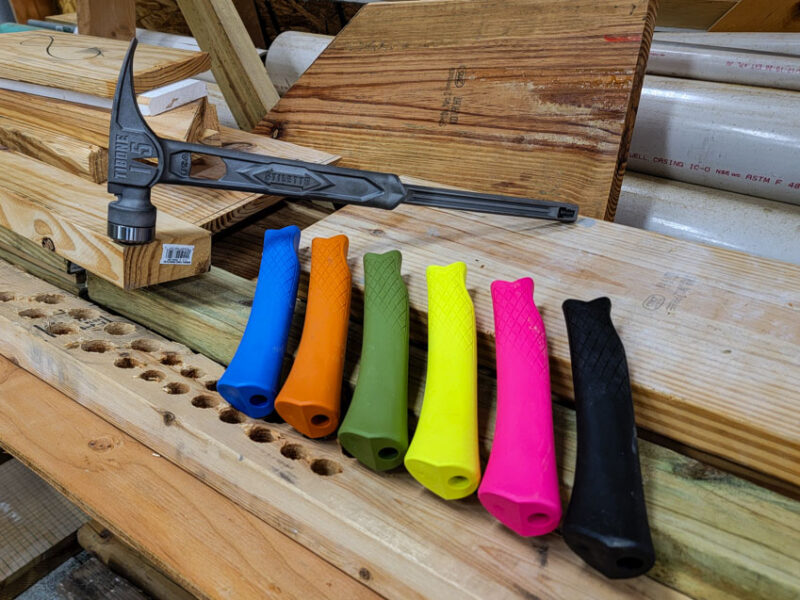
We’ve been using Stiletto titanium hammers since 2010. Our first experience came with the Stiletto 12 oz Titanium Remodeler hammer. We could care less about the multi-color replaceable handles. Stick with black; this isn’t kindergarten. However, we do like that you can replace both the grip and the face—the two wearable parts of this tool. That makes your $300 investment one that should last a lifetime—unless you lend it to a friend or lose it.
Weight and balance are perfect on this framing hammer. We recommend and prefer the milled face, though you can swap it for a smooth face ($35) or even use an available mallet cover ($20). The extra-deep magnetic nail holder with brass bushing allows for confident starts and a full strike on the nail head. A side nail puller gives you tons of leverage. Stiletto (now owned by Milwaukee Tool) even makes this hammer in the USA. You can find a less expensive hammer, but we doubt you’ll find a better one.
Pros
- Excellent balance and strong striking
- Lightest hammer we’ve used in this class
- Replaceable face and handle
- Available mallet cover
Cons
- Expensive (this is an investment)
- Poor choice if you’re prone to losing tools
Features
- 100% titanium (not a cheap alloy)
- Straight claw
- Side nail puller
- 6 available grip colors (T25 Torx retention at base of hammer)
- Milled or smooth face
- Price: $299.99
Best Framing Hammer for Demolition
DeWalt DWHT51008 ToughSeries 22oz Demo Hammer
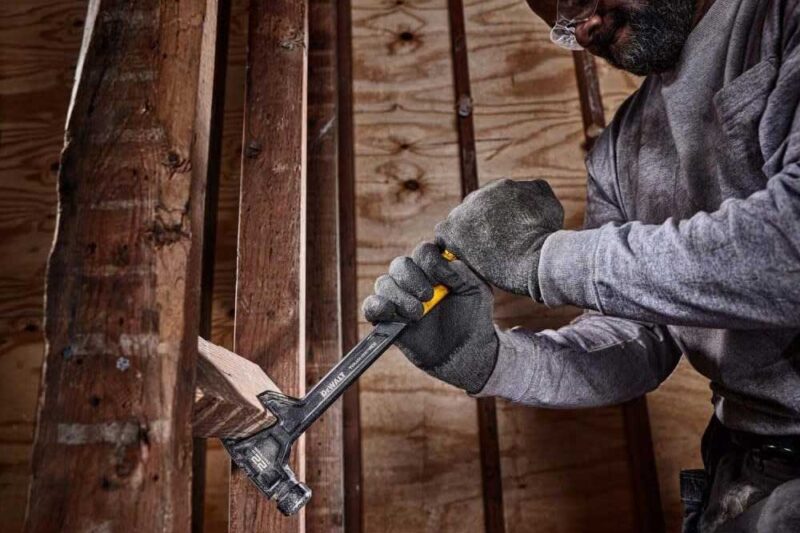
This hammer has an oversized strike face and a handy grip point on the handle. While its swing differs from that of a traditional steel hammer—it resembles the Stanley Fatmax Fubar. I use it to grip and twist 2x4s effectively when using a nailer (in your other hand) to secure studs. I also love the integrated side nail puller which also has a second slot. This makes it an effective staple puller as well.
With a milled face, it functions as an excellent framing hammer. I like the magnetic nail starter and the thick grip (though yellow gets dirty fairly quickly). The near-straight claw allows for plenty of leverage and this is my go-to hammer when framing walls as I use it to grasp and twist 2X studs to straighten them out before nailing to the bottom plate. Works great for blocking as well.
Pros
- Great for twisting/straightening framing material
- Durable 1-piece build quality
- Framing, finish, and staple removal
Cons
- Non-removable face
Features
- 22 oz. alloy steel
- Straight claw
- Side nail and staple puller
- Magnetic nail starter
- Milled face
- Price: $35
Best Wood-Handled Framer
Vaughan & Bushnell 2170 Dalluge 21 oz. Framing Hammer
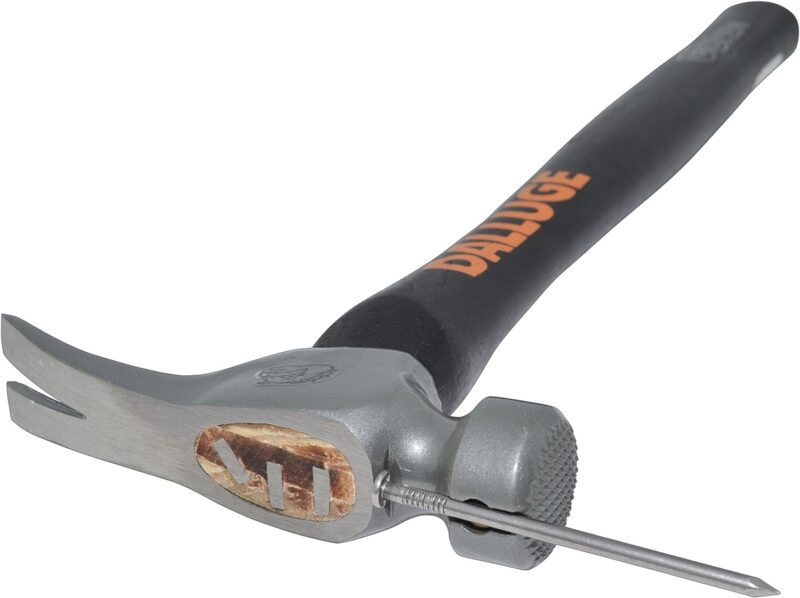
The Vaughan & Bushnell 2170 Dalluge Framing Hammer features a 21-ounce waffled head. As a framing hammer, we love the simple design. The 17-inch hickory handle feels great in the hand and gives you a comfortable swing. The black color is nice and doesn’t affect the feel and vibration-dampening characteristics of hickory. The steel head on this hammer also features a magnetic nail holder. Of all the hammers I tested, this tool felt most like the quintessential framer.
Pros
- Comfortable hickory handle
- Indented magnetic nail holder
- Straight claw with high leverage
Cons
- Non-removable face
Features
- 22 oz. alloy steel
- Straight claw
- Side nail and staple puller
- Magnetic nail starter
- Milled face
- Price: $36
Best Steel Framing Hammer
ToughBuilt ShockStop 20 oz. Milled Face
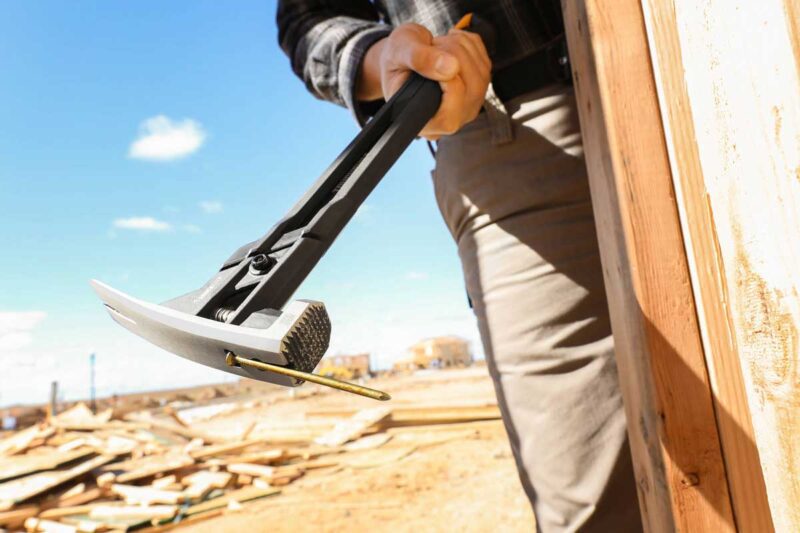
Coming to market with a metal-handled hammer proves tricky since other well-established tools already exist. The ToughBuilt ShockStop differs from others in its very design. Rather than a single-forged handle and head, ToughBuilt decoupled the head from the handle and added a ShockStop system to further reduce recoil. I’ve struck everything with this hammer—from studs to steel and the reduction in vibration works without diminishing the effectiveness of the blows.
While the handle sports an unusual design, I found it comfortable to use—even after long periods of framing up walls. The rubber overmold comforts your grip while providing a slip-free experience. The oversized striking head also reminds me of my old Douglas hammer—though without the inverted design. You get a single-piece head with a front-forward design that hits hard and stays on target. A recessed magnetic nail starter holds large nails well and works flawlessly.
At $45, this hammer is my favorite steel hammer and is easy to recommend. Swing it a few times and you’ll be hooked. if you can’t afford titanium, this is your next best bet.
Pros
- Extremely low recoil
- 20oz or 24oz sizes available
- Straight claw with high leverage
- Larger, rectangular striking surface
Cons
- No side nail puller
Features
- ShockStop decoupled head
- Sizes: 20/24 oz.
- Faces: Milled or smooth
- Magnetic nail starter
- Price: $45
Best Value Framing Hammer
Vaughan California Framing Hammer 19oz Milled Face
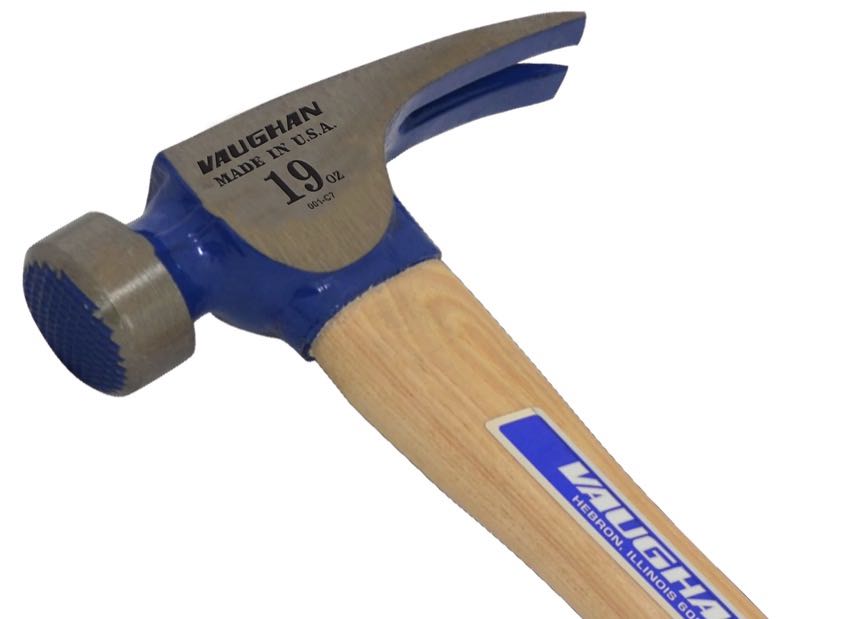
For years, the most ubiquitous hammer was the Estwing 24 oz. steel framer. At $40-50, however, the 19oz Vaughan California Framing Hammer with milled face seems to deliver more for less. The $28 Vaughan California Framer offers consistent performance with a traditional feel.
I really like the balance of this tool. The face, while not aggressively textured, provides good “grip” on nails as yiou strike. The traditional claw provides enough leverage and you don’t get many frills—but that’s what we like about this budget hammer.
Pros
- Superb value
- Made in the USA
- Replaceable handle
- Magnetic nail starter
Cons
- None at this price
Features
- Hickory handle
- Sizes: 16/24 oz.
- Face: Milled
- Magnetic nail starter
- Price: $28
Best-Selling Framing Hammers
While we certainly tested our share of framing hammers, the market has its own ideas. For that reason, we like to see what people are buying at top retailers. The lists below show the top three framing hammers sold at several top stores. If you don’t like our list, perhaps you can find something appealing here.
Amazon
- Irwin 16 oz Fiberglass Hammer – $10
- Estwing 16 oz Framing Hammer – $25
- Irwin 24oz Demolition Steel Framing Hammer – $28
Acme Tools
- Stiletto TRIMBONE 10oz Titanium Finish Hammer – $290
- Milwaukee 22 oz Milled Face Framing Hammer – $28
- Stanley 16 oz FatMax Xtreme AntiVibe Hammer – $23
Lowe’s
- ToughBuilt ShockStop 20 oz Milled Face Framing Hammer – $45
- Estwing 28 oz Milled Face Steel Framing Hammer – $35
- Kobalt 20 oz Milled Face Steel Head Wood Framing Hammer – $25
Home Depot
- Milwaukee 19 oz Milled Face Hickory Framing Hammer – $27
- DeWalt 22 oz Steel Framing Hammer – $30
- Husky 22 oz Milled Face Steel Framing Hammer – $24
How We Make Our Picks
To better understand some hammer technology (yes, there actually is technology involved), it makes sense to have a quick science lesson on the physics of a hammer.
Don’t worry, this won’t hurt much.
How Mass Plays a Role – WARNING: Math Ahead!
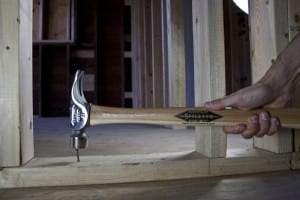
A hammer is a force amplifier that converts mechanical work into kinetic energy and back again. When swinging a hammer, kinetic energy gets stored in the hammer’s head. The kinetic energy equals the length of the swing times the force produced by your muscles (and gravity). When the hammer strikes the nail, the nail stops the head with an equal and opposite force.
Where this gets tricky is when you start to take into consideration the effect of the mass of the hammer’s head. The amount of energy delivered to the nail by the hammer is equal to one-half the mass of the head times the square of the head’s speed at the time of impact. The key here is that the energy delivered to the nail increases linearly with mass but it increases quadratically with the speed.
KE = 1/2 mv2
Let me summarize that for you: An easier-to-swing hammer delivers more energy to the nail. This forms one of the key arguments in the titanium hammers vs steel hammers debate.
Hammer Handles Matter Too
Lightweight hammer heads allow for faster swing velocity, but handle designs can also help the efficiency of your swing. That includes taking into account vibration-absorbing materials, length, and angle. Essentially, to find the best framing hammer, it will have to have a combination of certain head and handle qualities that make it feel “right”.
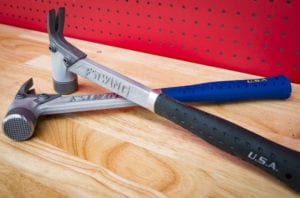
There are literally hundreds of hammers out there, so for the sake of time and practicality, we tried to limit the playing field to framing hammers whose head weights ranged in the low to mid 20 ounces, had long handles, straight rip claws, and milled faces. Both titanium and steel models were acceptable. Our list of hammers is in no way inclusive of all that is available. There are many more manufacturers and models that I did not get a chance to put my hands on yet. Perhaps I’ll have to revisit this after I collect and evaluate all of the hate mail I’m sure to get following this best-framing hammer review. (I did mention this was a contentious topic, did I not?)
Measuring and Weighing the Best Framing Hammers
I started by weighing each hammer. Then I measured the face size using calipers, handle length with a tape measure, and set up a grid to make comparing and evaluating the various tools easier. When I measured the face, I didn’t use the outer diameter of the head, but rather the area of the milled surface. In almost every hammer that space is smaller than the head’s full outer diameter. I figured it was more important to know the actual striking area of the hammer as opposed to the full head size.
It is also interesting to note that while some hammers might have a lightweight head, the handles sometimes add back enough weight to counteract any gains achieved in shaving off some extra steel. We point this out because a hammer’s weight is more than just the head. It’s the entire hammer (a number that manufacturers don’t always prominently advertise).
Manually Testing the Framing Hammers
I tested out each hammer with both bright and galvanized 16-penny (16D) nails. I drove the nails into spruce studs and some pressure-treated 4x4s. Since so much of a hammer’s function is dependent on the skill and technique of the user, extensive testing is not necessary for the scope of this article. In other words—I didn’t have to drive in thousands of nails before drawing some conclusions.
I took lots of breaks so that a tired arm or a sore wrist wouldn’t sway me. Perhaps in the future, when time and budget permit, I can develop a piece of scientific equipment to analyze things like striking force, vibration, and swing efficiency. While it would be cool to have statistics on these variables, this is ultimately a subjective topic requiring a subjective review.
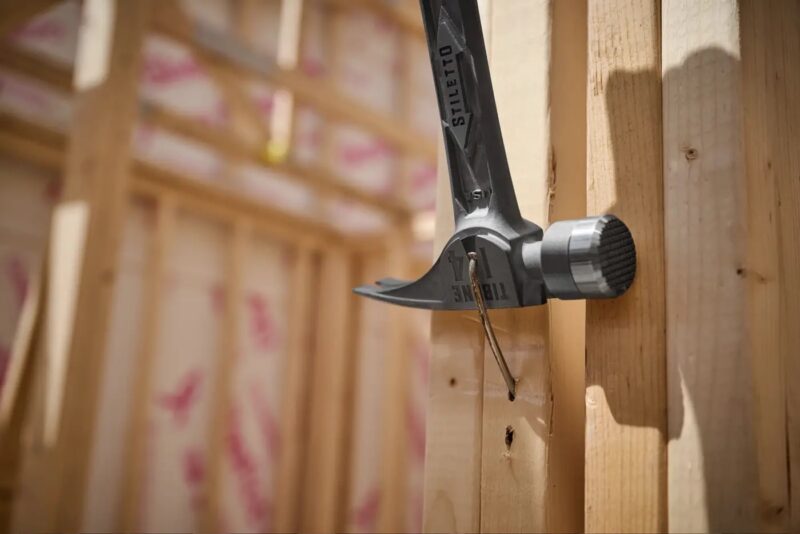
Reviewing hammers is just like reviewing trucks. Some Pros are polarized on which brand they like. You can test, re-test, and crown a winning truck of the year (every year). Everyone still has their personal preference on what pickup they want to drive.
Maybe the best hammer test would have all participants blindfolded and I could hand them a random hammer to see what they think. While they wouldn’t be swayed by brands, colors, materials, and logos, it might be one of the more painful tests we’ve ever run!

Value, Features, and Performance
After spending some time with all of the hammers I ended up with this list of what I felt were the best. I based this on their value, features, and overall perception of their performance. Of course, nearly any framing hammer will drive a nail. However, not all of them will do it well. In addition to my beloved “benchmark” Douglas framing hammer, I tested steel and titanium selections from Stiletto, Estwing, DeWalt, Vaughan, and others. I also looked at a cross-section of synthetic, steel, and wood handles.
In the same way that I prefer Ford trucks, I might also display a slight bent towards more traditional hammers. This entire experience remains largely subjective.
While I may prefer particular features, the best test of a hammer is picking one up and taking a swing!
Why You Can Trust Pro Tool Reviews
Ever check out a “review” site and you can’t tell if they actually tested the tools or if they’re just “recommending” the Amazon top sellers? That’s not us. We won’t recommend anything unless we’d actually use it ourselves and we don’t really care who the primary retailer is. It’s all about giving you a legitimate recommendation and our honest opinion of each product.
We’ve been in business since 2008 covering tools, writing reviews, and reporting on industry news in the construction, automotive, and lawn care industries. Our Pro reviewers work in the trades and have the skills and experience to know whether tools can perform well in the field.
Each year, we bring in and review hundreds of individual products. Our team will put our hands on hundreds of additional tools at media events and trade shows throughout the year.


